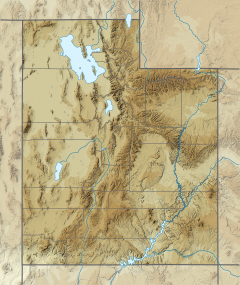Mount Watson (Utah)
| Mount Watson | |
|---|---|
 Southeast aspect | |
| Highest point | |
| Elevation | 11,521 ft (3,512 m)[1] |
| Prominence | 1,141 ft (348 m)[1] |
| Parent peak | Bald Mountain (11,949 ft)[1] |
| Isolation | 3.53 mi (5.68 km)[2] |
| Coordinates | 40°41′54″N 110°58′48″W / 40.6983670°N 110.9799104°W[3] |
| Geography | |
| Country | United States of America |
| State | Utah |
| County | Summit |
| Parent range | Uinta Mountains Rocky Mountains |
| Topo map | USGS Mirror Lake |
| Geology | |
| Rock age | Precambrian[4] |
| Rock type | Arenite, Arkose[4] |
| Climbing | |
| Easiest route | class 2 hiking[1] |
Mount Watson is an 11,521-foot-elevation (3,512-meter) mountain summit in Summit County, Utah, United States.
Description
[edit]Mount Watson is set within the Uinta-Wasatch-Cache National Forest.[2] It is situated in the western Uinta Mountains which are a subrange of the Rocky Mountains. Precipitation runoff from this mountain drains north into the Weber River and south into headwaters of the Provo River. Topographic relief is significant as the summit rises 1,700 feet (518 meters) above Middle Fork Weber River in one mile (1.6 km). Access to the mountain is via the Mirror Lake Highway and hiking. The mountain was so named around 1900, and the toponym was officially adopted in 1932 by the U.S. Board on Geographic Names.[5]

Climate
[edit]Based on the Köppen climate classification, Mount Watson is located in a subarctic climate zone with cold snowy winters and mild summers.[6] Tundra climate characterizes the summit and highest slopes.
See also
[edit]References
[edit]- ^ a b c d "Watson, Mount - 11,521' UT". listsofjohn.com. Retrieved June 2, 2024.
- ^ a b "Mount Watson, Utah". Peakbagger.com. Retrieved June 2, 2024.
- ^ "Mount Watson". Geographic Names Information System. United States Geological Survey, United States Department of the Interior. Retrieved June 2, 2024.
- ^ a b Gwendolyn W. Luttrell, Lexicon of New Formal Geologic Names of the United States 1981–1985, U.S. Geological Survey Bulletin, U.S. Government Printing Office, 1983, p. 211.
- ^ United States Board on Geographic Names, Decisions of the United States Geographic Board, October 5, 1932, p. 28.
- ^ Peel, M. C.; Finlayson, B. L. & McMahon, T. A. (2007). "Updated world map of the Köppen−Geiger climate classification". Hydrol. Earth Syst. Sci. 11 (5): 1633–1644. Bibcode:2007HESS...11.1633P. doi:10.5194/hess-11-1633-2007. ISSN 1027-5606. S2CID 9654551.
External links
[edit]- Mount Watson: weather forecast


 French
French Deutsch
Deutsch
